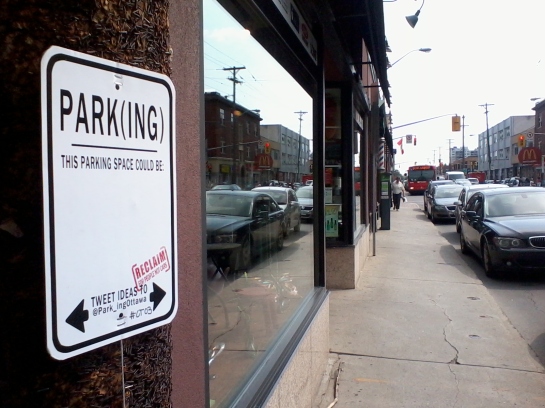Originally published in Centretown Buzz and Spacing Ottawa
by Sarah Gelbard

“Down by the bay (street)” and “Cheese of the World.” Photos by Christopher Ryan.
What is architecture and who is an architect? We all sort of know but sort of don’t. I have been studying, designing, and writing about architecture for fifteen years and I don’t really know. I can say the answer is not as simple as “an architect makes architecture, and architecture is something made by architects.”
Last month I attended Critic’s Night at the Phi Centre in Montreal co-hosted by the Maison de l’architecture du Québec (MAQ) and the Royal Architectural Institute of Canada (RAIC). The evening included a wonderful bilingual discussion between two greatly respected architecture critics; former New York Times architecture critic Paul Goldberger and Emmanuel Caille, senior editor of D’architectures.
M. Caille is an architect. Mr. Goldberger is not. Both are obviously exceptionally knowledgeable about architecture. Both are highly influential voices in architecture. They raised some very important issues and questions about the role of criticism and what it contributes to architecture.
A damaging review by a theatre critic or food critic might shut-down the show or restaurant. It is hard to imagine that a bad review by an architecture critic has ever shut-down a building or stopped people who planned to use it from using it. So what is the point of architecture critics if the object of their criticism is already built and not going anywhere?
There are many reasons why architectural criticism and journalism are important:
- It advocates for and sets a bar for good and better architecture.
- It gives the general public increased access to understanding what can seem to be an overwhelmingly insiders’ discipline.
- It gives architects recognition for their hard work.
- It also keeps architects accountable to the general public.
Architecture has the potential for huge public impact. Codes and regulations keep architecture physically safe and keeps architects accountable to public safety. Critics and academics help to give us the tools to understand and evaluate—among other things—the social and cultural impact of architecture. Afterall, it is not enough for architects to produce something to make their clients happy and just conforms to codes.
Hopefully, architecture criticism and journalism make us all better critics and appreciators of architecture. It gives more people access to understanding what architects do, what architecture can be, and what standards we should expect. It raises the discussion beyond personal taste. It can help us place architecture in the context of the important issues that shape our cities; economic, social, environmental, political, historical, and aesthetic issues.
The world celebrated Jane Jacobs’ 100th birthday this month. As one of the greatest critics of the 20th century, Jacobs had a greater impact on the shape of our cities than any architect. She reminded us that cities are not just skyscrapers and freeways. Not just built by planners and architects.
I love reading and talking with fellow architecture critics, writers, and journalists. Again, some have architectural training, some do not. We come to architecture from different paths but share a passion for our shared subject. Here in Ottawa, Jonathan McLeod, often discuss architecture and urban design, both in his Ottawa Citizen articles and on his blog “Steps from the Canal.”







 Cities are communities. While we all have our private concerns, goals, and obligations, as a city we also have to think collectively about our shared public lives and spaces. “Public” is at the centre of many city debates and comes up a lot in this column.
Cities are communities. While we all have our private concerns, goals, and obligations, as a city we also have to think collectively about our shared public lives and spaces. “Public” is at the centre of many city debates and comes up a lot in this column.